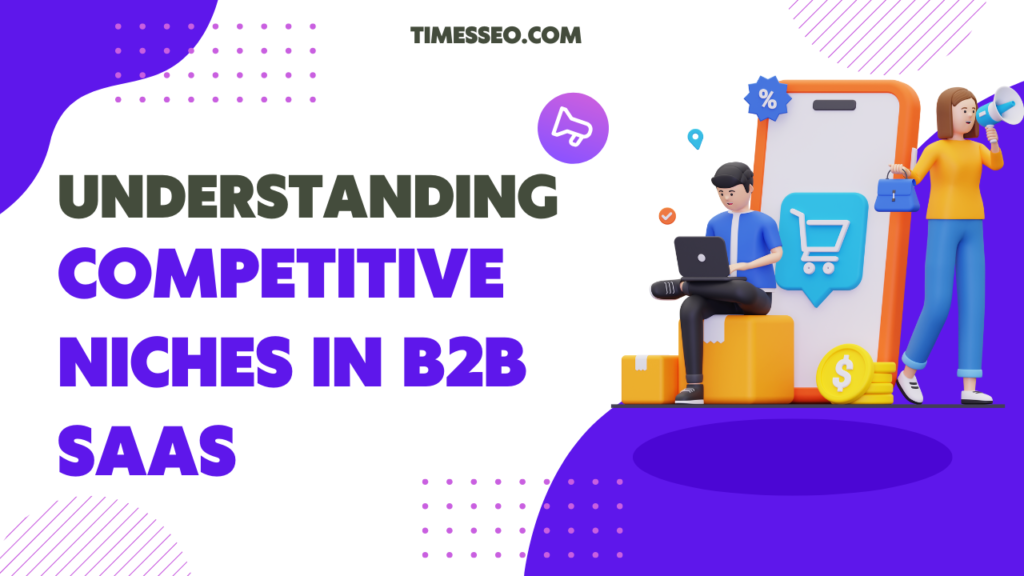
Link Building for B2B SaaS Sites in Competitive Niches
This blog post explores effective strategies for link building for B2B SaaS sites in highly competitive niches. Discover how to acquire high-quality, niche-relevant backlinks to improve your search rankings, increase authority, and drive targeted traffic for long-term SaaS growth.
Table of Contents
Introduction
Let’s be real—ranking a B2B SaaS site in a competitive niche feels like climbing Everest with flip-flops. There are hundreds of companies, all fighting for the same traffic, leads, and top spots on Google. But there’s one powerful lever you can still control: link building.
No, link building isn’t dead. It’s just evolved. Especially in saturated SaaS markets, getting high-quality, niche-relevant backlinks is one of the best ways to boost your authority and visibility without burning money on ads.
Understanding Competitive Niches in B2B SaaS
What Makes a Niche “Competitive”?
If your niche is packed with well-funded competitors, legacy brands, or VC-backed startups, you’re in a competitive space. Think CRM tools, project management software, AI platforms, or marketing automation.
Examples of Saturated SaaS Markets
- CRM (Salesforce, HubSpot, Zoho)
- Team Collaboration (Slack, Asana, Monday)
- Email Marketing (Mailchimp, ConvertKit, ActiveCampaign)
- Analytics & BI Tools (Tableau, Looker, Power BI)
These markets are SEO battlefields. You’ll need every edge you can get.
The Role of Link Building in SEO for SaaS
Authority, Trust, and Ranking Power
Backlinks are the internet’s equivalent of endorsements. Search engines have more faith in your material when credible websites connect to you.
Traffic + Trust = Leads
High-authority links can drive referral traffic, too. Additionally, you want the correct kind of traffic in B2B SaaS, not just any traffic.
Why Traditional Link Building in SaaS Often Doesn't Work
- Generic Outreach Fatigue: Everyone’s sending the same outreach templates. Editors tune it out.
- Lack of Relevance: Random links from irrelevant blogs offer zero long-term value.
- Penalty Risk: Buying links, spinning content, or joining shady link networks can backfire hard.
Setting Up a Strategic Link Building Foundation
Know Your Audience and Keywords
Target decision-makers, not just marketers. Align your content and link-building efforts with terms your ICP actually searches.
Map Content to the Buyer Journey
Create link-worthy content for each stage:
- Awareness: Industry reports
- Consideration: Comparison pages
- Decision: Case studies
Set Clear Goals and KPIs
Know what success looks like. Is it Domain Rating growth? Organic traffic? Better rankings for bottom-funnel keywords?
Building Links with High-Value Content
- Data Studies: Original research or industry benchmarks earn links naturally.
- Ultimate Guides: Detailed and skimmable long-form material continues to rule the market.
- Product Comparisons: Pages like “Best [Your Product Type] Alternatives” attract links from roundup creators and reviewers.
Using Competitor Backlink Analysis
Tools to Use
- Ahrefs
- SEMrush
- SpyFu
How to Find Gaps
Look for backlinks your competitors have that you don’t—especially from review blogs, podcasts, or directories.
Advanced Guest Posting Strategies
Target Industry-Specific Blogs
Skip the general marketing blogs. Instead, go niche—like SaaS review sites, growth hacking platforms, or dev communities.
Leverage Team Expertise
Your CEO or CTO likely has unique insights. Use their voice to land high-authority guest posts or podcast invites.
Partnerships, Integrations & Co-Branding
- API Integrations: Often come with a link from the partner’s website or docs.
- Co-Branded Content: Share whitepapers or webinars and double the link potential.
- Partner Pages: Build a “partners” section and ask for reciprocal linking (without it feeling spammy).
HARO and Digital PR for Authority Links
HARO = Help A Reporter Out. Journalists use it to find expert quotes.
How to Stand Out
- Respond fast (within 15–30 minutes)
- Keep answers concise and unique
- Include a brief bio + headshot
Turn PR Wins into Content
Write a “Featured In” blog post summarizing your media coverage—bonus SEO value.
Customer Success and Case Study Link Building
Highlight your clients with in-depth stories. Then:
- Ask them to share on their blog
- Highlight their endorsements (and request a reciprocal backlink)
Creating Tools, Templates, and Resources
- ROI Calculators
- Cost-Saving Templates
- Audit Checklists
Make them embeddable or easy to share with credit, and the backlinks will follow.
Community and Ecosystem-Based Links
Join SaaS-focused:
- Reddit threads (e.g., r/SaaS)
- Slack groups like MicroConf
- Discord servers for bootstrapped founders
Contribute first—pitch later.
Anchor Text and Link Placement Best Practices
- Use a mix: branded + natural + partial-match
- Avoid keyword stuffing (especially in guest posts)
- Aim for contextual links inside the body, not just in author bios
Measuring Link Quality and SEO Impact
What Makes a Link “Good”?
- Relevance to your niche
- Traffic potential
- Domain authority (DA/DR)
- Placement location (body vs. footer)
Track With These Tools
- Google Search Console
- Ahrefs or Moz
- Google Analytics
Scaling Link Building Without Spam
Smart Automation Tools
- BuzzStream
- Respona
- Pitchbox
Automate outreach without losing personalization.
Outsource (But Carefully)
Avoid cheap Fiverr gigs. Use screened independent contractors or specialist SaaS link-building companies instead.
Create SOPs
Build systems: prospecting → outreach → content → follow-up → tracking.
Conclusion
Link building for B2B SaaS in competitive niches isn’t a hack—it’s a strategy. When you approach it with precision, personalization, and value, you can outpace even the biggest players in your industry.
Build relationships. Share real insights. And most of all—earn your links by being genuinely helpful.
Frequently Asked Questions
Typically 3–6 months, depending on content quality, niche difficulty, and site authority.
If you lack the time or team, yes—but vet them for relevance, transparency, and ethical practices.
Use data, tools, integrations, and partnerships to earn links passively.
Sometimes, but Google’s getting smarter. Focus on earned, organic links to stay safe.
There’s no magic number—it depends on content quality, link authority, and your competitors’ profiles.
Table of Contents
Popular Posts
-
 Affordable Technical SEO Audit for Small Business: A Complete Guide26 Jun 2025 Blog
Affordable Technical SEO Audit for Small Business: A Complete Guide26 Jun 2025 Blog -
 How to Get an Affordable Technical SEO Audit for Small Business27 Jun 2025 Blog
How to Get an Affordable Technical SEO Audit for Small Business27 Jun 2025 Blog -
 The Ultimate Local SEO Audit Checklist for Startups28 Jun 2025 Blog
The Ultimate Local SEO Audit Checklist for Startups28 Jun 2025 Blog -
 Local SEO Audit Checklist for Startups: A Beginner’s Guide28 Jun 2025 Blog
Local SEO Audit Checklist for Startups: A Beginner’s Guide28 Jun 2025 Blog -
 Top On-Page SEO Audit Steps for Service Websites Every Business Should Know29 Jun 2025 Blog
Top On-Page SEO Audit Steps for Service Websites Every Business Should Know29 Jun 2025 Blog -
 Technical SEO for WordPress: The Ultimate Beginner’s Guide01 Jul 2025 Blog
Technical SEO for WordPress: The Ultimate Beginner’s Guide01 Jul 2025 Blog -
 The Impact of On-Page SEO Audit Steps for Service Websites on UX01 Jul 2025 Blog
The Impact of On-Page SEO Audit Steps for Service Websites on UX01 Jul 2025 Blog -
 Technical Mobile SEO Audit Tips for Developers02 Jul 2025 Blog
Technical Mobile SEO Audit Tips for Developers02 Jul 2025 Blog -
 Complete SEO Backlink Audit Guide for Better Google Rankings03 Jul 2025 Blog
Complete SEO Backlink Audit Guide for Better Google Rankings03 Jul 2025 Blog -
 Boost Your Rankings with Technical SEO for WordPress01 Jul 2025 Blog
Boost Your Rankings with Technical SEO for WordPress01 Jul 2025 Blog






